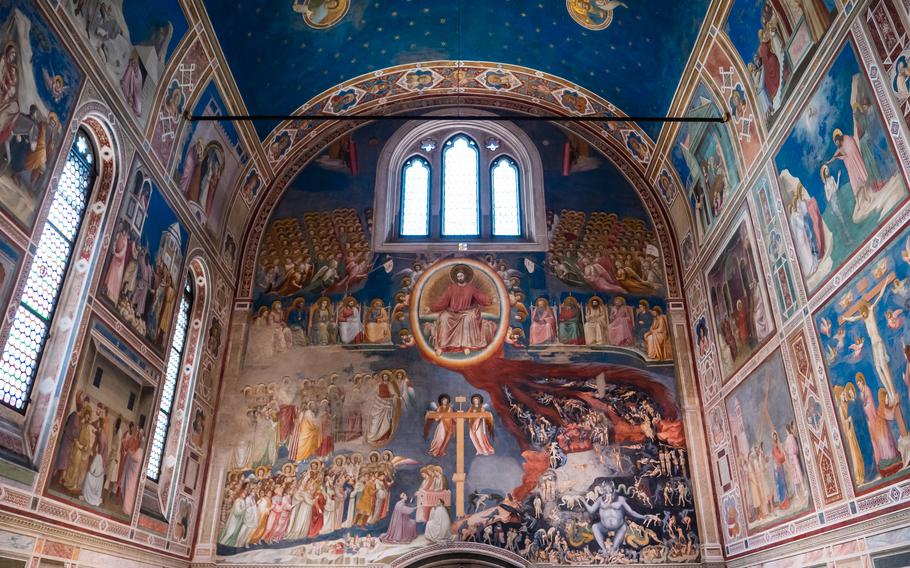
The Scrovegni Chapel in Padua, Italy, contains 38 frescoes by artist Giotto di Bondone from the life of Mary and Jesus. (iStock)
Armchair and actual travelers alike perk up and take note upon hearing a city, region or place of interest bears the UNESCO World Heritage Site designation; a lucky few even make it their life’s mission to visit as many such areas as possible. Those whose access to travel opportunities is far more restricted might use the label as a factor in determining where to spend their precious few vacation days. But the designation is meant to do something quite different than leading tourists to the next big thing.
UNESCO – or United Nations Educational, Scientific and Cultural Organization) – sums up its mission as follows: to encourage the identification, protection and preservation of cultural and natural heritage around the world considered to be of outstanding value to humanity. The visibility that comes with inclusion on the List is a double-sided coin. Tourist spending can be great for local businesses, but huge visitor numbers can tax a fragile site to its limit.
Once awarded, the designation does not exist in perpetuity, and a site with misguided management can fall from grace. This year, the World Heritage Committee decided to delete the UK property “Liverpool – Maritime Mercantile City” from the List, deeming the Liverpool Waters development project destructive to the site’s authenticity as one of the world’s major trading centers to emerge in the 18th and 19th centuries. Liverpool was only the third property to lose its World Heritage status, following the Elbe Valley in Dresden, Germany and the Arabian Oryx Sanctuary in Oman.
Since the naming of the first 12 sites back in 1978, the list has been lengthened considerably, and following the inclusion of an additional 34 properties in July 2021, the number currently stands at 1,154 properties: 897 cultural; 218 natural and 39 mixed. These are just a few of Europe’s 15 newest inscriptions and the reason for their inclusion.
Belgium and Netherlands: Colonies of Benevolence
The Colonies of Benevolence were remote peat and heath wastelands colonized as a model for pauper relief in the 19th century. The goal was to reduce urban poverty by providing the poor, beggars, vagrants and orphans with plots for agriculture and animal husbandry. Two types of colony existed: a free colony set up to help poor citizens and an unfree colony, where people were sent by the state and forced to live under a strict regime and under constant observation. Four settlements have been included: The Wortel in Belgium and Frederiksoord, Wilhelminaoord and Veenhuizen, in the Netherlands. Things to see include residential buildings, farm houses and other communal facilities. Online: kolonienvanweldadigheid.eu/en
France: Cordouan Lighthouse
This lighthouse stands at the mouth of the Gironde estuary in southwest France, which is formed from the meeting of the rivers Dordogne and Garonne downstream from the center of Bordeaux. Rising up from its rocky plateau in the Atlantic Ocean four miles out to sea, the structure built at the turn of the 16th and 17th centuries was built with the ambition of continuing the tradition of famous beacons of antiquity. Late 18th century alterations attest to the progress of science and technology. The lighthouse can only be visited by boat. Transfer services are offered from both Port-Médoc in Verdon-sur-Mer and the port of Royan. A 1.5 hour visit led by a lighthouse keeper is free of charge. Online: phare-de-cordouan.fr
Germany: Mathildenhöhe Darmstadt
The Darmstadt Artists’ Colony was established in 1897 by Ernst Ludwig, Grand Duke of Hesse, as a center for emerging reform movements in architecture, arts and crafts. The colony’s buildings were created by the artist members themselves and underwent expansion four times through 1914. Today the site serves as a testimony to early modern architecture, urban planning and landscape design, all of which were influenced by the Arts and Crafts movement and the Vienna Secession. The Wedding Tower, Plane Tree Grove, Russian Chapel of St. Maria Magdalena and the Lily Basin are just some of the 23 elements of this two-part property. Online: mathildenhoehe.eu
Italy: Padua’s fourteenth-century fresco cycles
Within the historic walled city of Padua are found eight building complexes housing a selection of fresco cycles painted between 1302 and 1397. Painted by various artists and found in both churches and secular buildings, the frescos maintain a unity of style and content and illustrate how fresco art developed along a new creative impetus and understanding of spatial representation. Sites not to miss include the Scrovegni Chapel, where artist Giotto di Bondone painted 38 scenes from the life of Mary and Jesus, and the Basilica of St. Anthony, with its life-size representation of the patron saint of lost things. St. Anthony died in Padua in 1231 and was proclaimed a saint just a year later. Online: whc.unesco.org/en/list/1623
Austria, Belgium, Czech Republic, France, Germany, Italy, United Kingdom: The Great Spa Towns of Europe
The 11 towns selected for inclusion on the list are examples of the European spa culture that developed around natural mineral water springs from the early 18th century to the 1930s. Grand international resorts, spa building ensembles dedicated to therapeutic procedures, colonnades, galleries and related facilities such as gardens, casinos and theaters blend to create picturesque urban environments and showcase developments in medicine, science and balneology. The properties include Baden bei Wien, Austria; Spa, Belgium; Františkovy Lázně, Karlovy Vary and Mariánské Lázně, Czech Republic; Vichy, France; Bad Ems, Baden-Baden and Bad Kissingen, Germany; Montecatini Terme, Italy; and the City of Bath in the United Kingdom.